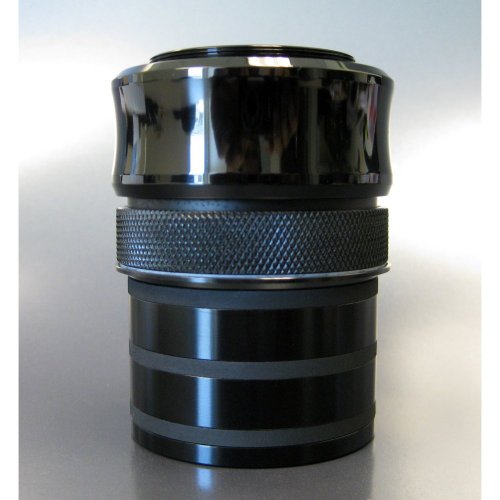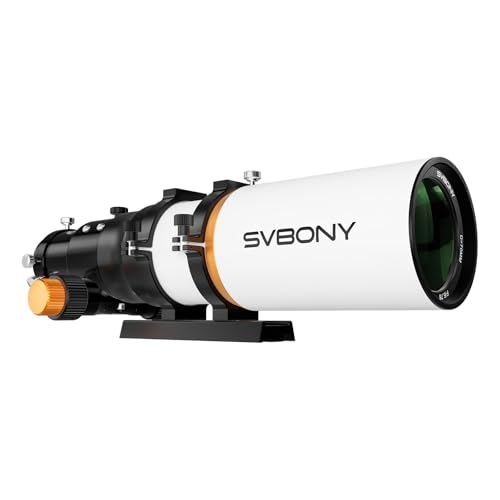If you’re looking to improve your astrophotography, selecting the right field flattener can make a huge difference. These devices correct field curvature and reduce star distortion, giving you sharper images across your entire frame. Popular options include models from Explore Scientific, SVBONY, Sky-Watcher, and AstroTech, designed for different focal ratios and telescope setups. I’ll guide you through the top 15 best flatteners so you can choose what fits your needs perfectly.
Key Takeaways
- Field flatteners minimize star distortion and field curvature, ensuring sharp, distortion-free images across the entire camera sensor.
- Compatible with various refractor telescopes, especially those with focal ratios between f/4 and f/8.
- Fully multi-coated optics enhance light transmission, contrast, and image clarity for high-quality astrophotography.
- Easy to install with threaded connections, often including filter threads or T-ring compatibility for versatile setup.
- They expand the field of view, support full-frame cameras, and improve overall image quality for deep sky astrophotography.
Explore Scientific Field Flattener for Refractor Telescopes
If you’re serious about astrophotography with a refractor telescope, the Explore Scientific Field Flattener is an excellent choice because it’s specifically designed for telescopes with focal ratios of f/5 to f/7. It effectively minimizes star distortion caused by field curvature, ensuring sharp, high-quality images across the entire field of view. Easy to install with a secure T-ring connection, it uses fully multi-coated optical glass to maximize light transmission and contrast. Placed between your telescope and camera, it corrects image distortions, helping you capture clearer, more detailed images of planets, nebulae, galaxies, and star clusters. It’s a reliable tool for enhancing your astrophotography.
Best For: astrophotographers using refractor telescopes with focal ratios of f/5 to f/7 seeking to improve image sharpness and reduce star distortion across the entire field of view.
Pros:
- Effectively minimizes field curvature, resulting in sharper images.
- Fully multi-coated optical glass maximizes light transmission and contrast.
- Easy to install with a secure T-ring connection compatible with various cameras.
Cons:
- Requires precise spacing (55mm +/- 2mm) for optimal performance, which may need careful adjustment.
- Designed specifically for f/5 to f/7 focal ratios, limiting compatibility with other telescopes.
- May add some additional weight and length to the optical setup.
SVBONY SV193 Focal Reducer for SV503 Telescope
The SVBONY SV193 Focal Reducer for the SV503 Telescope stands out as an essential tool for astrophotographers seeking sharp, wide-field images. Its 0.8x reduction shortens focal length, enabling faster exposures and minimizing star distortion at the edges. Designed specifically for the SV503 80mm F7 ED model, it features a 2-inch front socket and M48x0.75 threading, supporting full-frame cameras and filters. Made from durable materials, it guarantees reliable performance during sessions. This focal reducer not only improves image quality but also simplifies setup, making it a versatile addition for both amateur and advanced astrophotographers aiming for crisp, expansive celestial shots.
Best For: astrophotographers using the SV503 80mm F7 ED telescope seeking to achieve sharp, wide-field celestial images with reduced exposure times.
Pros:
- Effectively shortens focal length for faster imaging sessions.
- Minimizes star distortion at the edges for clearer, sharper images.
- Compatible with full-frame cameras and standard 2-inch filters for versatile use.
Cons:
- Designed specifically for the SV503 model, limiting compatibility with other telescopes.
- May require additional adapters for some camera or filter setups.
- Slight reduction in image brightness due to focal reduction, which might necessitate longer exposures in some cases.
SVBONY SV209 Field Flattener, 0.8X Focal Reducer
For astrophotographers using the SV550 122mm f/7 apo refractor, the SVBONY SV209 Field Flattener, 0.8X Focal Reducer offers a compelling upgrade to image quality. It corrects field curvature, expanding the field of view and ensuring sharp focus across the entire frame, including corners of DSLR and CCD sensors. By reducing focal length from 854mm to 683.2mm and converting f/7 to f/5.6, it also increases photographic speed. Designed with a 63×1 thread, it easily screws into your focuser for a secure fit. This device enhances your imaging performance, making it a valuable addition to your astrophotography setup.
Best For: astrophotographers using the SV550 122mm f/7 apo refractor seeking to improve image sharpness, expand field of view, and increase photographic speed.
Pros:
- Corrects field curvature for sharp focus across entire image frame, including corners
- Widens the field of view and reduces focal length from 854mm to 683.2mm, enhancing imaging area
- Easy to install with a secure 63×1 metric thread connection
Cons:
- Designed specifically for the SV550 122mm f/7 apo refractor, limiting compatibility with other telescopes
- May require additional adapters if used with different focuser types
- Slight reduction in focal length might not suit all astrophotography needs
HOTECH SCA 2 Inch Field Flattener for Refractor Telescopes
When aiming for sharp, distortion-free astrophotography across your entire telescope field, the HOTECH SCA 2 Inch Field Flattener is an excellent choice. Designed for refractor telescopes, it features a fully multi-coated two-element lens that maximizes light transmission and image quality. Compatible with f/5 to f/8 refractors, it ensures bright, crisp images from edge to edge. The built-in 2″ filter thread and T-ring compatibility make attaching filters and cameras straightforward. Its center-loading design with a compression ring guarantees precise camera alignment, minimizing vignetting. Although discontinued, it remains popular among astrophotographers seeking reliable, high-quality field flattening for detailed, wide-field astrophotography.
Best For: astrophotographers using refractor telescopes seeking to achieve sharp, distortion-free images across the entire field of view.
Pros:
- Fully multi-coated two-element lens maximizes light transmission and image clarity
- Compatible with f/5 to f/8 refractors for a wide range of telescopes
- Built-in 2″ filter thread and T-ring compatibility simplify camera and filter attachment
Cons:
- Discontinued by the manufacturer, potentially limiting availability and support
- May require careful threading and alignment for optimal performance
- Limited customer reviews available, making it harder to gauge long-term reliability
SVBONY Focal Reducer for SV503 102mm ED Telescope
If you’re seeking a reliable focal reducer that enhances your SV503 102mm ED telescope’s imaging capabilities, the SVBONY Focal Reducer is an excellent choice. It offers 0.8x reduction and field flattening, making it ideal for full-frame astrophotography. Constructed with multi-coated optics and a lightweight aluminum body, it ensures durability and high image quality. Compatibility is straightforward, with threaded connections for filters and cameras, though proper focus requires removing the nose piece and possibly using an extension tube. Rated 4.6 stars, users praise its build and performance, making it a cost-effective tool for wider, sharper celestial images.
Best For: astrophotographers seeking to improve image quality and widen their sky coverage with their SV503 102mm ED telescope.
Pros:
- Provides 0.8x reduction for wider field imaging and better star focus
- Built with multi-coated optics and lightweight aluminum for durability and ease of use
- Compatible with various filters and cameras for versatile astrophotography
Cons:
- Achieving perfect focus may require removing the nose piece and using an extension tube
- The included nose piece can cause focus issues if not adjusted properly
- May require some initial setup adjustments for optimal flat-field imaging
SVBONY SV503 Refractor Telescope with Built-in Field Flattener
The SVBONY SV503 Refractor Telescope stands out as an ideal choice for astrophotographers seeking seamless, wide-field imaging without the hassle of additional accessories. Its built-in field flattener corrects field curvature, delivering distortion-free, sharp images of galaxies, nebulae, and star clusters. The 70mm aperture at F/6.78, combined with ED glass, reduces chromatic aberration for true-to-life colors. The dual-speed focuser allows precise adjustments, while the 0.8x focal reducer expands the field of view. Its sturdy, portable design, along with excellent build quality and high customer ratings, makes it a versatile, high-value scope perfect for astrophotography and visual observation.
Best For: amateur astrophotographers and visual astronomers seeking a portable, high-quality refractor with wide-field imaging capabilities and minimal need for additional accessories.
Pros:
- Built-in field flattener providing distortion-free, sharp images across the entire field of view
- ED glass and high-quality optics minimize chromatic aberration and false color
- Durable, portable construction with precise dual-speed focuser and stable mount
Cons:
- Limited aperture size may restrict deep-sky object brightness compared to larger scopes
- First availability date of May 10, 2025, indicates it may not be immediately accessible for purchase
- Slight halos around bright stars, which may require post-processing correction
Astromania 2 Field Flattener for Astronomy Photos
The Astromania 2 Field Flattener excels at producing sharp, distortion-free images across the entire field of view, making it an ideal choice for astrophotographers seeking perfect star images from their refractor telescopes. Compatible with telescopes from f4 to f8, it features M48 threading for full aperture illumination at 2 inches. Its back focus of 109mm provides flexibility for various accessories. Designed to address field curvature, it ensures pin-sharp stars even at the edges. Multi-coated lenses reduce reflections and enhance image quality. Weighing just 8.8 ounces, it’s a lightweight yet effective tool for achieving flat, high-quality astrophotos.
Best For: astrophotographers using refractor telescopes from f4 to f8 who need precise, flat-field images for capturing sharp star fields.
Pros:
- Produces pin-sharp stars across the entire image field, including edges
- Fully compatible with a range of refractor telescopes from f4 to f8
- Features multi-coated lenses that reduce reflections and enhance image clarity
Cons:
- Weighs only 8.8 ounces, which may be too lightweight for some mounting setups requiring sturdiness
- Limited to use with telescopes that have M48 threading and compatible back focus requirements
- Requires additional accessories or adapters for some specific telescope configurations
SVBONY SV503 Refractor Telescope, 102mm F7 Achromatic Refractor OTA
Designed for astrophotographers seeking sharp, high-contrast images, the SVBONY SV503 Refractor Telescope offers a 102mm aperture paired with an F/7 ratio, making it ideal for deep sky and planetary imaging. Its doublet air-spaced achromatic lens with S-FPL51 ED glass minimizes chromatic aberration, delivering accurate, vibrant images. The fully multi-coated optics maximize light transmission, enhancing brightness and contrast. Features like a smooth dual-speed focuser, retractable dew shield, and 360° field rotator provide precise adjustments and ease of use. Lightweight and durable, it’s a versatile scope suitable for both astrophotography and visual observing, delivering high-quality results at an affordable price point.
Best For: amateur astronomers and astrophotographers seeking an affordable yet high-quality refractor telescope for deep sky, planetary, and terrestrial observations.
Pros:
- High optical quality with minimized chromatic aberration thanks to S-FPL51 ED glass
- Smooth dual-speed focuser and precise adjustments for detailed imaging and viewing
- Portable, lightweight, and durable construction suitable for travel and field use
Cons:
- Slight field curvature when using focal reducers may require post-processing corrections
- Residual halos around very bright stars, common in achromatic lenses
- Limited back focus (90mm), which may restrict certain accessories or camera setups
SVBONY SV193 Focal Reducer 2 Inch 0.8X Field Flattener
If you’re serious about astrophotography with your refractor telescope, the SVBONY SV193 Focal Reducer 2 Inch 0.8X Field Flattener offers a essential upgrade by providing a wider field of view and sharper images across the entire frame. Designed specifically for refractors like the SV503 80ED, it supports full-frame cameras and connects via a 2-inch front socket with M48x0.75 threading. It reduces focal length, boosts image brightness, and minimizes star distortion at the edges. The result is flat, high-quality celestial images, perfect for capturing detailed planets and deep-sky objects, making your astrophotography more precise and stunning.
Best For: astrophotographers and amateur astronomers seeking to enhance their refractor telescope’s image quality, field of view, and star point accuracy in celestial imaging.
Pros:
- Supports full-frame cameras, enabling high-resolution astrophotography
- Reduces focal length and star distortion for sharper, more detailed images
- Compatible with SV503 80ED refractor telescope, ensuring seamless integration
Cons:
- Designed primarily for refractor telescopes, limiting use with other telescope types
- Requires careful threading and connection setup for optimal performance
- May represent a higher investment compared to basic focal reducers
SVBONY SV503 Portable Telescope Tube
For astrophotographers and avid observers seeking portability without sacrificing image quality, the SVBONY SV503 Portable Telescope Tube stands out with its high-quality optics and lightweight design. It features an S-FPL51 ED glass element that virtually eliminates chromatic aberration, delivering sharp, high-contrast images perfect for both astrophotography and visual use. Its 2-element objective and micro-reduction RAP focuser support heavy accessories, ensuring stability during imaging sessions. Designed for travel and mobile astronomy, the SV503 offers versatility for moon, nebulae, galaxies, and terrestrial observation. Its combination of optical excellence and portability makes it an excellent choice for those on the go.
Best For: amateur astronomers and astrophotographers seeking a portable, high-quality telescope for travel, terrestrial viewing, and astrophotography.
Pros:
- Utilizes high-quality S-FPL51 ED glass to virtually eliminate chromatic aberration, ensuring sharp, high-contrast images
- Features a lightweight, portable design ideal for travel and mobile astronomy sessions
- Supports heavy photographic accessories with a micro-reduction RAP focuser for stable imaging
Cons:
- The 2-element objective may limit some advanced imaging capabilities compared to larger, more complex telescopes
- May require additional accessories for optimal astrophotography setup
- Limited aperture size may restrict deep-sky object visibility for advanced users
Astromania 2 Field Flattener for Astronomy Photos
The Astromania 2 Field Flattener stands out as an excellent choice for astrophotographers seeking sharp, distortion-free images across their entire frame. It’s designed for refractors with focal ratios from f/4 to f/8, featuring an M48 thread for full aperture illumination at 2″ and accommodating accessories within 109mm back focus. Its main strength is addressing field curvature, producing uniformly sharp stars from center to edge—something often missed with visual or small-chip camera setups. The multi-coated lenses reduce reflections and enhance image brightness. Overall, it’s a reliable tool for capturing high-quality, flat images with minimal optical aberrations.
Best For: astrophotographers using refractor telescopes with focal ratios from f/4 to f/8 seeking sharp, distortion-free images across their entire frame.
Pros:
- Produces uniformly sharp stars from center to edge of the image.
- Reduces optical aberrations and addresses field curvature effectively.
- Features multi-coated lenses that minimize reflections and enhance brightness.
Cons:
- Designed specifically for refractors within a limited focal ratio range, limiting compatibility with other telescope types.
- Requires a back focus of up to 109mm, which may necessitate additional accessories.
- May be more costly compared to simpler, single-element adapters or flatteners.
SVBONY SV260 2 Telescope Filter for SV503 Refractor Telescope
Astrophotographers seeking to enhance their deep-sky imaging in light-polluted areas will find the SVBONY SV260 2 Telescope Filter an excellent choice because it effectively blocks artificial light while maintaining high transmission of celestial signals. This multi-bandpass broadband filter isolates six levels of light pollution, enabling nebulae and stars to shine through with rich, true-to-life colors. With over 90% peak transmittance and a strong OD4 light-pollution cut-off, it minimizes light loss and enhances image quality. The built-in field flattener in the SV503 refractor ensures sharp, wide-field views, making this filter ideal for capturing detailed, vibrant astrophotos.
Best For: Astrophotographers and astronomers seeking to capture detailed, vibrant deep-sky images in light-polluted environments.
Pros:
- High over 90% peak transmittance for minimal light loss
- Effectively blocks multiple levels of light pollution with OD4 cut-off
- Built-in field flattener ensures sharp, wide-field images with minimal distortion
Cons:
- Designed specifically for SV503 refractor telescopes, limiting compatibility with other models
- May require precise calibration for optimal performance in certain conditions
- Price may be higher compared to single-band filters due to multi-bandpass capabilities
SVBONY SV503 Refractor Telescope with Built-in Field Flattener and SV305C Pro Telescope Camera
Looking for a telescope that combines premium optical performance with integrated features? The SVBONY SV503 Refractor Telescope with built-in field flattener is an excellent choice. Its flat-field design eliminates field curvature, providing wide, sharp, distortion-free images across the entire view. The 70mm aperture and F/6.78 focal ratio deliver bright, detailed images of galaxies, nebulae, and star clusters. Paired with the SV305C Pro Camera, which boasts high sensitivity and low noise, you can capture stunning planetary and deep-sky images. This setup is perfect for both amateurs and advanced astronomers seeking high-quality, true-to-life imaging with minimal aberrations.
Best For: amateur and advanced astronomers seeking high-quality, distortion-free planetary and deep-sky imaging with integrated optical features.
Pros:
- Built-in field flattener ensures wide, sharp, and distortion-free images across the entire field of view.
- ED glass and flat-field design minimize chromatic aberration, providing true-to-life colors and high clarity.
- High-sensitivity IMX662 camera captures detailed planetary and deep-sky images with low noise and high frame rates.
Cons:
- The setup may be relatively expensive for beginner astronomers on a tight budget.
- Requires proper alignment and calibration for optimal performance, which could be complex for novices.
- Limited aperture size (70mm) compared to larger telescopes, which may restrict deep-sky object viewing in very faint conditions.
Sky-Watcher Evolux 62ED Reducer/Flattener (0.9X)
For those seeking sharp, flat-field images with their refractor telescopes, the Sky-Watcher Evolux 62ED Reducer/Flattener (0.9X) stands out as an excellent choice. It’s designed specifically for flat-field astrophotography, reducing focal length to allow shorter exposures and minimize distortions. With a 62mm aperture, f/5.8 focal ratio, and a 360mm focal length, it offers a wide 30mm illuminated field. Compatibility with M56x1 female and M48 male threads makes it versatile. Plus, it includes a rotator/adapter with a built-in cavity for 2-inch filters, streamlining your imaging setup for better results.
Best For: amateur astronomers and astrophotographers seeking high-quality, flat-field imaging with their refractor telescopes, especially those aiming to reduce exposure times and minimize distortions.
Pros:
- Designed specifically for flat-field astrophotography, ensuring sharp, distortion-free images
- Includes a rotator/adapter with built-in cavity for 2-inch filters for versatile imaging setups
- Compact and lightweight design makes it easy to handle and integrate into existing setups
Cons:
- Compatibility limited to telescopes with M56x1 female or M48 male threads, requiring adapters for other models
- May require additional accessories for complete integration with some telescope mounts
- Fixed focal length reduction of 0.9X may not suit all imaging needs or focal length preferences
SVBONY SV220 Dual-Band Nebula Filter with SV503 70mm Refractor Telescope
The SVBONY SV220 dual-band nebula filter paired with the SV503 70mm refractor telescope offers a powerful combination for anyone aiming to capture detailed images of emission nebulae and other deep-sky objects, even in light-polluted areas. The filter enhances contrast by reducing unwanted light pollution from moonlight and artificial sources, making nebulae and faint objects stand out more clearly. The telescope’s built-in field flattener ensures sharp, wide-field images with minimal distortion, while the high transmission rates of the filter reveal intricate details. Together, they provide a versatile setup perfect for astrophotographers seeking crisp, high-contrast images under challenging skies.
Best For: Amateur and professional astrophotographers seeking to capture detailed images of emission nebulae and deep-sky objects in light-polluted areas with a versatile, high-performance setup.
Pros:
- Significantly reduces light pollution, enhancing contrast for clearer nebulae and deep-sky object imaging.
- The dual-band filter’s high transmission improves detail and sharpness in astrophotography.
- The SV503 70mm refractor’s built-in field flattener ensures wide, distortion-free, sharp images with minimal aberrations.
Cons:
- The setup may require precise alignment and calibration for optimal results.
- The filter and telescope may be less effective for very faint objects without additional accessories.
- The system’s performance depends on sky conditions; in extremely bright urban environments, results may still be limited.
Factors to Consider When Choosing Field Flatteners for Refractor Telescopes

When choosing a field flattener, I consider factors like compatibility with my telescope’s focal ratio and back focus needs to guarantee proper fit. I also look at the quality of optical coatings for clear images and whether it can expand my field of view effectively. Finally, ease of installation is important so I can set it up quickly without hassle.
Compatibility With Focal Ratios
Choosing a field flattener that matches your refractor telescope’s focal ratio is crucial for achieving sharp, distortion-free images. Most flatteners are designed for specific focal ratios, typically between f/5 and f/7, which are common for many refractors. Using a flattener intended for a different focal ratio can cause inadequate correction or introduce optical distortions, compromising image quality. Many flatteners specify a recommended focal ratio range, so selecting one within that range ensures excellent performance. If your telescope’s focal ratio is near the edge of the flattener’s range, you might need to adjust the back focus distance for proper correction. Compatibility with focal ratios directly impacts the effectiveness of the field flattening and the overall quality of your astrophotography results.
Back Focus Requirements
Back focus distance is a key factor in getting the most out of your field flattener. It refers to the exact space between the flattener and your camera sensor needed for precise image correction. Most refractor telescopes and flatteners specify a back focus of around 55mm, which guarantees proper focus and minimizes distortions. If this distance isn’t maintained, you might see star elongation, blurring at the edges, or incomplete correction of field curvature. To achieve the correct back focus, you can use extension tubes or spacers to fine-tune the setup. Getting this measurement right is vital for maximizing the flattener’s effectiveness, leading to sharper, more accurate astrophotos free of distortion and edge aberrations.
Optical Coatings Quality
Optical coatings play a crucial role in ensuring your field flattener delivers peak performance. High-quality coatings on lenses boost light transmission, making your images brighter and more contrasty. Fully multi-coated lenses reduce reflections and glare, which minimizes optical aberrations and sharpens image clarity. These multi-layer coatings also protect the surfaces from dust, moisture, and scratches, enhancing durability and maintaining consistent performance over time. Superior coatings help achieve uniform illumination across the entire field of view, reducing vignetting and edge distortions that can compromise image quality. Ultimately, the quality of optical coatings directly impacts how well your flatener maintains sharp star points from the center to the edges of your images, ensuring your astrophotography results are as clear and detailed as possible.
Field of View Expansion
Have you ever noticed star images that look stretched or distorted at the edges? That’s often due to optical distortions in your telescope’s field of view. Field flatteners help expand the usable area by correcting these distortions, resulting in more uniform images. They enable astrophotographers to capture wider fields without vignetting or edge elongation, making your photos look sharper from center to edge. Choosing the right flattener ensures that star points remain sharp across the entire sensor, maximizing your telescope’s effective field coverage. This means you can take longer exposures in wide-field astrophotography without worrying about post-processing corrections. Keep in mind, compatibility with your telescope’s focal ratio and sensor size is key to achieving ideal field of view expansion and overall image quality.
Ease of Installation
When selecting a field flattener for your refractor telescope, ease of installation can save you both time and frustration. I recommend choosing a model with compatible thread sizes and mounting mechanisms that match your telescope’s focuser or visual back. This simplifies attaching the flattener without needing adapters or modifications. Verify if the flattener requires specific spacing, like a precise distance between the device and your camera sensor—this ensures straightforward setup. Look for models that include clear, step-by-step instructions or diagrams, making installation more manageable. Additionally, adjustable focus settings or fixed focus options that match your imaging setup help reduce complex focusing adjustments. Accessories like T-ring adapters or extension tubes also make attaching and removing the flattener quick and tool-free, streamlining the entire process.
Build Durability
Choosing a durable field flattener is essential because it guarantees your equipment withstands regular use and transport without losing performance. I look for models made from high-quality, impact-resistant materials like metal or reinforced plastics, ensuring they can handle frequent handling. The optical components, such as fully multi-coated glass elements, should be securely bonded within the housing to prevent misalignment or damage over time. Robust threading standards like M48 or M56 are vital for a secure fit to your telescope and camera, reducing the risk of stripping or loosening. Weather-resistant features, including sealed or coated surfaces, protect against moisture, dust, and corrosion, extending the flattener’s lifespan. A well-designed, sturdy build maintains structural integrity across temperature changes, preventing warping and ensuring consistent optical performance.
Price and Value
Evaluating the price and value of a field flattener helps guarantee you make a smart investment without overspending on unnecessary features. I look at the cost relative to the optical quality and features offered. Cheaper options might lack essential coatings or have less precise construction, which can compromise image quality and force me to buy additional accessories. On the other hand, higher-priced flatteners often include advanced multi-coatings, better materials, and extra compatibility, delivering better long-term value. I compare prices across multiple sellers and check for warranties or customer support to ensure I get the best deal. Remember, an affordable model that meets my needs can sometimes be a smarter choice than a more expensive one with features I don’t need.
Frequently Asked Questions
How Do Field Flatteners Affect Image Brightness and Contrast?
Field flatteners generally don’t substantially affect image brightness or contrast. They primarily correct the curved field in your images, making stars appear sharp and focused across the frame. However, some flatteners may introduce slight light loss or subtle contrast changes, but these are usually minimal. Overall, I find that they improve image quality without compromising brightness or contrast, making my astrophotography sharper and more professional-looking.
Can Field Flatteners Be Used With Different Telescope Brands?
Think of a field flattener as a universal key that can unlock clarity across different telescope brands. Yes, you can use them with various refractors, but compatibility depends on your telescope’s focal length and thread size. I’ve found that choosing a flattener designed for multiple systems makes your astrophotography journey smoother, like a bridge connecting different worlds, ensuring sharp, beautiful images no matter your equipment brand.
What Maintenance Is Required for Field Flatteners Over Time?
Field flatteners need occasional cleaning to remove dust and smudges that can affect image quality. I also inspect the connections and guarantee the optical elements are free from scratches or dew buildup. Over time, I check for any signs of misalignment or wear, especially if I notice a drop in image sharpness. Proper storage in a dry, dust-free environment helps prolong their lifespan and sustain ideal performance.
Are There Specific Field Flatteners for Astrophotography Beginners?
Imagine your astrophotography journey as a smooth voyage across a clear night sky. For beginners, I recommend starting with simple, user-friendly field flatteners designed specifically for entry-level refractors. These tools act like a gentle guiding hand, helping you capture sharp, flat images without overwhelming complexity. Look for models with straightforward setup and clear instructions—think of them as your trusty compass in the vast, starry sea.
How Do I Determine the Correct Flattener for My Telescope’s Focal Length?
To determine the correct flattener for my telescope’s focal length, I check the manufacturer’s specifications or product descriptions, which often list compatible focal lengths. I also measure my telescope’s focal length or consult the user manual. If unsure, I contact the manufacturer or a knowledgeable retailer, providing my telescope model. This helps me select a flattener that guarantees sharp, flat images across the entire sensor.
Conclusion
Ultimately, choosing the perfect field flattener fuels your fascination with flawless, focused astrophotography. By balancing benefits with budget and being mindful of compatibility, you can confidently create crisp, mesmerizing cosmic captures. Don’t delay your discovery—delve into details, decide diligently, and drive your deep-sky dreams into dazzling reality. Remember, the right flattener fuels fun, fixes flaws, and fuels your passion for planetary, professional-quality astrophotography.

























